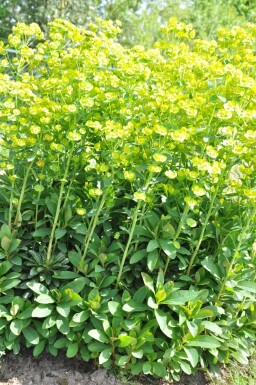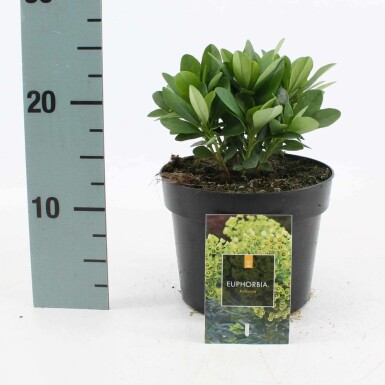




At Heijnen Plants, we take pride in offering a diverse selection of Euphorbia, commonly referred to as Spurge. This distinctive genus encompasses a variety of species, each showcasing a unique arrangement of green, blue, or grey foliage that adds a touch of subtle elegance to any garden composition. While Euphorbia does not bear fruit, it compensates with a striking display of yellow, green, or red flowers that emerge to add vibrant splashes of color. These hardy plants are a testament to both beauty and resilience, requiring minimal care while providing maximum visual impact.
The Euphorbia genus, commonly known as Spurge, encompasses a remarkably diverse group of plants, offering a wide array of colors and forms to the discerning gardener. These species are identified by their unique flower structures, which are often mistaken for petals but are in fact bracts that surround the plant's true flowers. Providing year-round interest with their foliage that comes in shades of green, blue, grey, purple, and silver, Euphorbias are a splendid choice for borders, group plantings, and edges.
Euphorbias are beloved for their distinctive appearance and ease of care, characterized by the following attributes:
To ensure your Euphorbia thrives, consider the following guidelines:
By incorporating these resilient and captivating plants into your garden, you will enjoy the striking colors and forms of Euphorbia species throughout the year.
Embrace the unparalleled vibrance that Euphorbia, commonly known as Spurge, brings to the garden. This diverse genus offers a spectacular array of foliage colors, intriguing forms, and a refreshing burst of spring and summer blooms that enliven any landscape. Whether planted en masse for dramatic effect or intermingled within a mixed border for textural contrast, these resilient and hardy perennials offer a visual feast that is sure to captivate the discerning gardener.
We would like to provide some tips on how to plant and care for a Euphorbia. By following these tips, you can be sure to enjoy your Euphorbia for a long time.
For optimal growth and display, position Euphorbias in a location that receives full sunlight or partial shade. These resilient plants are quite adaptable and can thrive in various soil types, provided the soil is well-drained. Their preference for sun-drenched spots allows their diverse foliage colors, ranging from green to silver, to truly stand out. Despite their average water needs, Euphorbias are drought-resistant, making them suitable for gardeners seeking low-maintenance options. They excel in border arrangements, group plantings, or as edging, adding texture and color to the landscape throughout the seasons.
This species thrives in a variety of well-drained soils and is versatile in terms of exposure, tolerating both full sun and partial shade. When planting, ensure that there is sufficient space for the plant to grow and expand, taking into account its mature size. After positioning in the ground, water the plant moderately to encourage establishment. During the growing season, maintain average water needs, allowing the soil to dry out slightly between waterings. The robust nature of this plant, along with its drought resistance, makes it a resilient choice for a range of garden settings.
To sustain the vivid foliage and striking blooms of the species, it is essential to provide it with adequate nutrition. Fertilizing in early spring, as growth commences, will bolster the species' vigor and flowering potential. Employ a balanced, slow-release fertilizer to nourish the plant throughout its active growing season. It is crucial to follow the manufacturer's instructions for the correct dosage to avoid over-fertilization, which can be detrimental.
Given its adaptable nature to various soil types, the plant does not require frequent feeding. An annual application of fertilizer should suffice. Should gardeners opt for organic alternatives, well-rotted compost or manure can be incorporated into the soil around the base of the plant to gradually improve soil fertility and structure.
The Euphorbia genus, known for its striking foliage and captivating blooms, typically requires minimal pruning. Deadheading is not necessary as these plants do not produce fruit. However, to maintain shape and encourage healthy growth, any spent or yellowing leaves can be removed. It's crucial to wear gloves when pruning Euphorbia, as the sap can be an irritant to skin and eyes. Cut back any damaged stems in late autumn or early spring, being careful to make clean cuts to prevent unnecessary stress to the plant.
Euphorbia species thrive with an average watering regimen, requiring consistent moisture, particularly when potted. It is advisable to permit the soil to dry out partially between waterings, as these plants are somewhat drought resistant. During the growing season, ensure the soil is evenly moist but never waterlogged. In winter, reduce watering frequency to prevent root rot, especially for the deciduous varieties that go dormant. Remember, well-drained soil is paramount to prevent excessive moisture accumulation around the roots.
Euphorbia thrives with minimal intervention, making it an excellent choice for both novice and experienced gardeners. Its latex-containing sap, which should be handled with care, is a natural deterrent for herbivores, ensuring that the plant remains robust and vibrant. Furthermore, this genus's extensive variety offers a splendid array of forms and sizes to suit any garden design, with some species showcasing striking foliage that provides year-round interest.
To encourage new growth and maintain the health of Euphorbia, division is an effective method of propagation. This should be carried out preferably during the cooler months of spring or autumn. Carefully remove the plant from its location, ensuring the root system is intact. Once removed, the root ball can be separated into smaller sections, each with a fair amount of roots and shoots. These divisions can then be replanted into well-draining soil, respecting the plant's preference for sun or partial shade. Regular division also helps manage the plant's size and promotes a more vigorous display of its colorful foliage and flowers.
The Euphorbia, with its unique and striking appearance, is an excellent choice for adding a touch of architectural flair to any space. This versatile genus offers a stunning array of forms and colors, making it a captivating focal point in both indoor and outdoor settings. Its resilience and ease of care are added benefits for any plant enthusiast.
